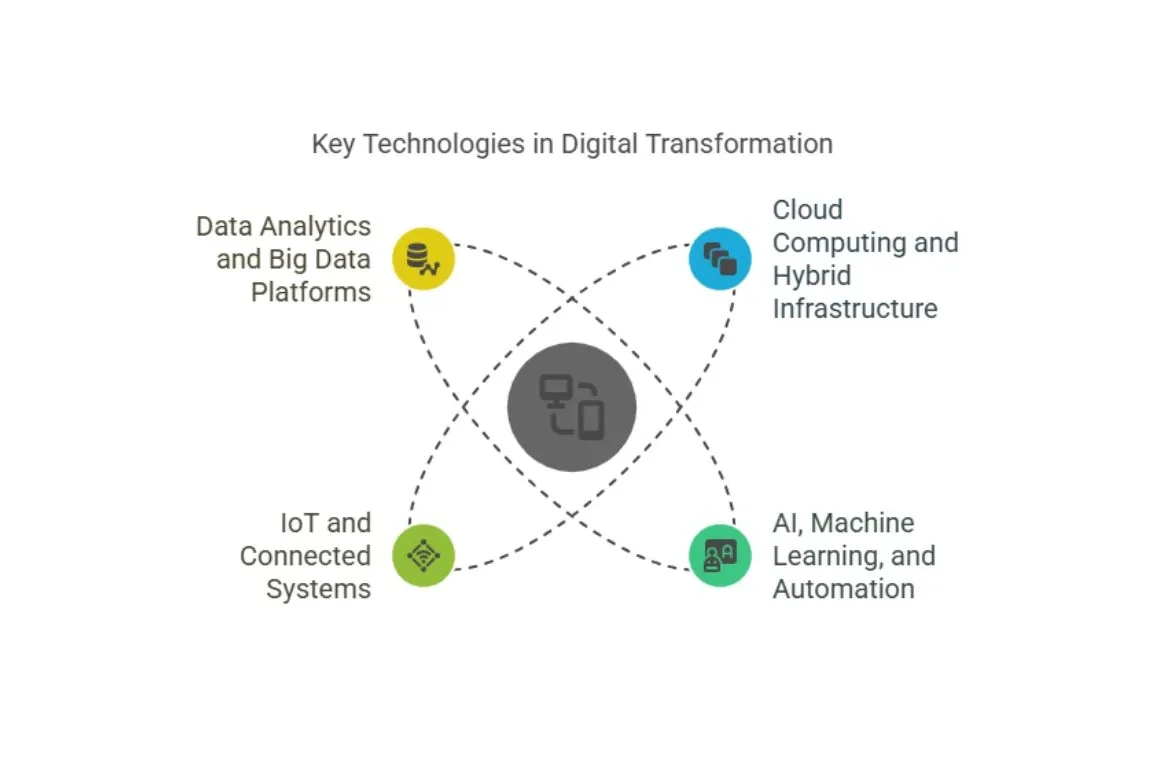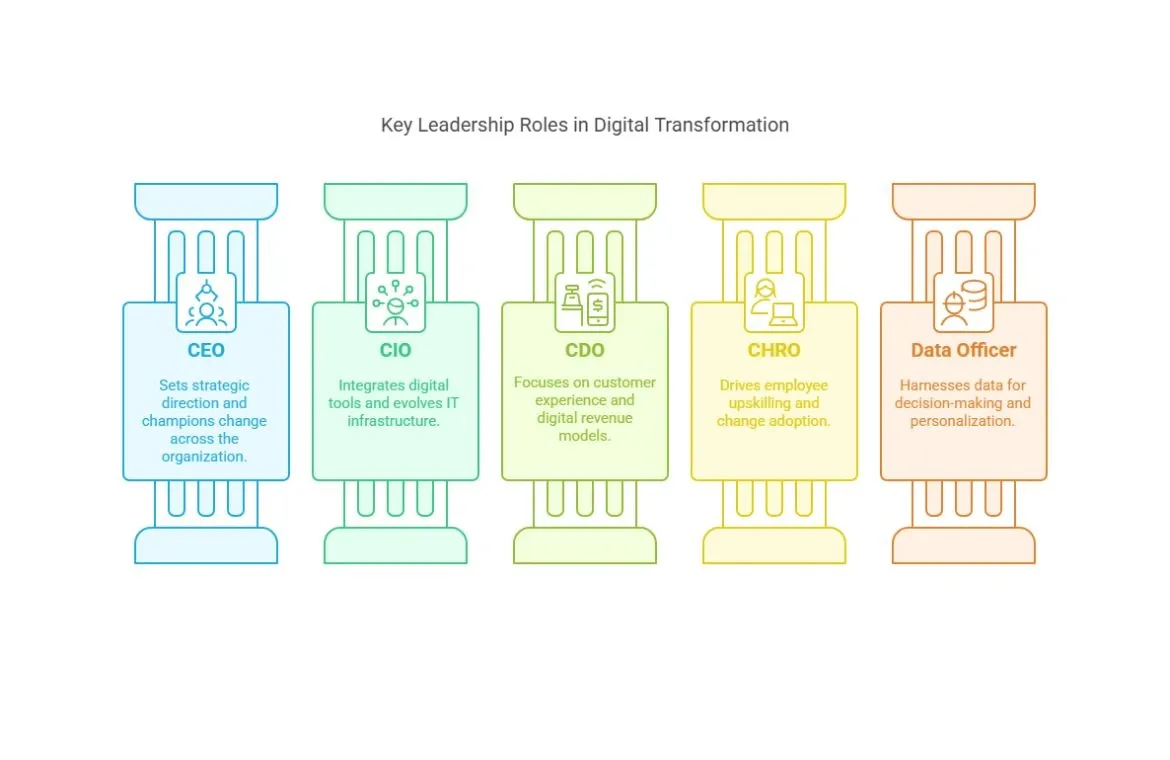Digital Transformation Explained: What It Is and Why It Matters?

"It’s not the strongest that survive, but those who are the most responsive to change."
Today, the businesses that thrive in this ever-evolving and competitive world are not the ones that have made a big impact, but they have become more adaptable to ongoing changes. They are adjusting and refining their strategies accordingly through digital transformation.
Digital Transformation is the need of the hour, and its meaning can go far beyond our thinking, as it is much more than adding new technologies. A detailed business strategy drives this change. Companies must integrate digital technology throughout their operations to modernise their processes and products.
This article covers what digital transformation is, its essential concepts, and practical implementation strategies.
What is Digital Transformation?
Digital transformation means using technology to make a business work faster, smarter, and more efficiently. In simple terms, it’s about replacing old, manual ways of doing things with digital tools, such as using software instead of paperwork, apps instead of in-person services, and data to make better decisions. It helps businesses serve customers better, save time and money, and stay competitive in a digital world.
Key Technologies Driving Digital Transformation

Technology forms the backbone of successful digital transformation initiatives. These technologies create intelligent, connected ecosystems that reshape business operations and customer experiences.
Cloud computing and hybrid infrastructure
Cloud technologies create the foundation for digital transformation. Organisations can scale their IT infrastructure on demand, reduce costs, and help distributed teams collaborate more effectively. Cloud computing eliminates the costs of purchasing and maintaining on-premises hardware.
Hybrid infrastructure offers unique advantages for digital transformation through a strategic blend of internal data centers, cloud integration services, and external cloud environments.
AI, machine learning, and automation
Artificial intelligence and machine learning are at the vanguard of digital transformation. Organisations can automate complex tasks, extract insights from big data, and deliver personalised customer experiences. Automation has become a strategic business tool that addresses pain points and enhances employee productivity. Companies can scale operations efficiently.
IoT and connected systems
The Internet of Things (IoT) drives digital transformation by creating digital links between companies and customers. This technology starts with connectivity but gains value through digitisation. It collects source data from the physical world and converts it into useful business information.
Data analytics and big data platforms
Data analytics accelerates digital transformation efforts. These technologies utilise big data platforms to extract meaningful insights from vast information collections. Organisations can make analytical decisions. A digital transformation platform typically features a centralised system that enhances processes by leveraging data, particularly in data pipelines and operations.
Digitisation vs. Digital Transformation
Organisations need to understand the difference between digitisation and digital transformation when starting technology-driven change. These concepts represent different stages in an organisation's digital development, though people often use them interchangeably.
Digitisation creates digital versions of analog information without altering how people use it. The process focuses on recording data that can support digital technologies later. While digitisation plays a vital role, it doesn't change business models or operational processes on its own.
Why is Digital Transformation necessary?
Digital transformation has become more than a technological upgrade. It's a survival imperative. McKinsey research shows that approximately 90% of all organisations are going through some form of digital transformation.
This widespread adoption highlights its vital role in today's business world.
The pandemic made organisations realise they needed to adapt faster to supply chain disruptions, time-to-market pressures, and changing customer expectations. Many businesses learned tough lessons about digital readiness when their optimised systems were suddenly faced with changes in both demand and supply.
Customer behavior looks completely different now. Three out of four Americans explored new shopping options during the pandemic.
They moved substantially toward streaming services, online fitness, and digital grocery shopping. Business-to-business interactions also went online, and McKinsey data confirms that remote selling works well.
The Role of AI in Digital Transformation
Artificial Intelligence leads meaningful digital transformation and serves as both a catalyst and an enabler for organisations that seek competitive advantage. AI transformation strategically integrates AI into operations, products, and services to streamline processes and stimulate growth. This integration creates entirely new ways of doing business rather than simply replicating existing business processes with new technologies.
Benefits of Digital Transformation
The value of digital transformation extends far beyond the reach and influence of technology upgrades. It delivers high returns in organisations of all types.
Companies experience significant improvements in efficiency and productivity through digital transformation. Those who automate their operations report better run-rate efficiency. These gains come from technologies that speed up processes and require fewer manual tasks.
Customer experiences receive a significant boost through personalisation, multi-channel access, and customised service plans.
This focus on customers becomes more valuable as expectations change. It drives better retention, loyalty, and competitive edge.
Key benefits include:
- Better security with advanced features like multifactor authentication, encryption, and network segmentation
- Quick response to market changes through business flexibility
- Smart resource management with modern IT systems that combine processes
- New opportunities to create products and services through innovation
- Happy employees who stay longer - Most of product managers would switch jobs to work with better tech
Digital transformation makes innovation in business models possible. This is a vital skill in today's fast-changing market. Companies just need live data analysis and smart processes to effectively handle new business, payment, and service models.
How to Enable Digital Transformation in Your Organisation?
Digital transformation needs a well-laid-out approach, strategic planning, and regular measurement to succeed. Companies that take a comprehensive view of digital transformation are more likely to achieve medium to high enterprise value from their digital initiatives.
Assessing digital maturity and setting goals
Your organisation's digital maturity assessment should be the first step before starting your digital transformation. Digital maturity indicates how effectively your company utilises digital technology in its operations and culture.
Choosing the right technologies and partners
Technology selection is just one part of the transformation pussle. You should look for these qualities when picking partners:
- Real-life experience in your industry
- Proven skills with relevant technologies
- Strong change management abilities
- A culture that fits with your organisation
What are the key leadership roles in a digital transformation?

A digital transformation's success depends on good leadership. Digital transformation differs from regular projects because it needs specialised leaders who work together to meet shared goals. Digital Transformation isn’t about tech, it is a people powered movement
"Every successful digital transformation is powered by a team of forward-thinking leaders, those who shape the vision, nurture the culture, and drive execution from strategy to reality."
And Here’s a list of who they actually are :
Chief Executive Officer (CEO)
- Sets the strategic tone and aligns transformation goals with business outcomes.
- Acts as the change champion across all levels of the organisation.
Chief Information Officer (CIO)
- Leads the integration of digital tools and IT infrastructure.
- Ensures legacy systems evolve to support agile and scalable operations.
Chief Digital Officer (CDO)
- Focuses on customer experience, data strategy, and new digital revenue models.
- Bridges the gap between tech potential and business reality.
Chief Human Resources Officer (CHRO)
- Drives employee upskilling and champions a digital-first mindset.
- Manages change adoption and reduces resistance through communication and training.
Chief Data Officer / Analytics Leader
- Harnesses data to drive decisions and personalise customer experiences.
- Builds data governance frameworks and predictive models for growth.
Other important positions include Digital Project Managers, who run digital initiatives, and Digital Transformation Leads, who align transformation strategies. Strong teams also have business-technology liaisons, process experts, and champions who build excitement and secure funding.
Leaders in every role must create unified visions that go beyond technology. They break down organisational barriers and encourage cultural changes.
Conclusion
Digital transformation changes how organisations operate, compete, and deliver value in today's fast-moving business world. This article showed that this change goes beyond adopting new technology.
It represents a detailed rewiring of business operations that touches every part of an organisation. Success in digital transformation needs a balance between technological innovation, cultural change, strategic vision, and leadership dedication.
The path from digitisation to real transformation needs careful planning. Companies that take a strategic approach to digital transformation achieve better results than those who focus solely on individual tech projects. Organisations that build their digital capabilities step by step achieve higher gross margins than their slower competitors.
Leaders actually determine if a transformation succeeds. So, for those who are already leading an organisation and wish to elevate, or those who are on the path to become future leaders of this always online world, a Digital Business Leadership course can prove to be the right pathway to gain better insights, knowledge, and understanding of the digital world.
Because tomorrow's successful organisations see digital transformation as an ongoing process of reinvention rather than a one-time project, winners in this space will react faster to market changes. They will spot customer needs early and boldly reshape their business models.
“Digital transformation isn't just about technology - it's a core business strategy that helps companies thrive in our digital world.”
Frequently Asked Questions
Q1. What is digital transformation, and why is it important?
Digital transformation is the strategic integration of digital technologies across all business areas, changing how organisations operate and deliver value fundamentally. It's important because it increases efficiency, enhances business agility, and unlocks new value for employees, customers, and shareholders in a rapidly digitalising world.
Q2. What is the scope of digital transformation?
The scope of digital transformation encompasses all business functions, including operations, customer service, marketing, supply chain management, and human resources. It involves adopting digital tools, automation, data analytics, and cloud technologies to enhance efficiency, agility, and innovation, enabling organisations to stay competitive and deliver greater value in a digital-driven economy.
Q3. What are the Objectives of digital transformation?
The primary objectives of digital transformation are to enhance operational efficiency, improve customer experiences, and drive innovation through the use of technology. It aims to automate processes, enable data-driven decision-making, and foster agility across business functions. Digital transformation also seeks to increase scalability, reduce costs, and create new value streams by integrating digital tools.
Q4. What are the benefits of implementing digital transformation?
Digital transformation offers numerous benefits, including improved operational efficiency, enhanced customer experiences, strengthened security, increased business agility, better resource management, greater innovation capabilities, and improved employee satisfaction. It also enables organisations to develop new business models and respond quickly to market changes.

TalentSprint
TalentSprint is a leading deep-tech education company. It partners with esteemed academic institutions and global corporations to offer advanced learning programs in deep-tech, management, and emerging technologies. Known for its high-impact programs co-created with think tanks and experts, TalentSprint blends academic expertise with practical industry experience.



